大学英语写作课件4-Composing--essays
- 格式:pdf
- 大小:7.20 MB
- 文档页数:43
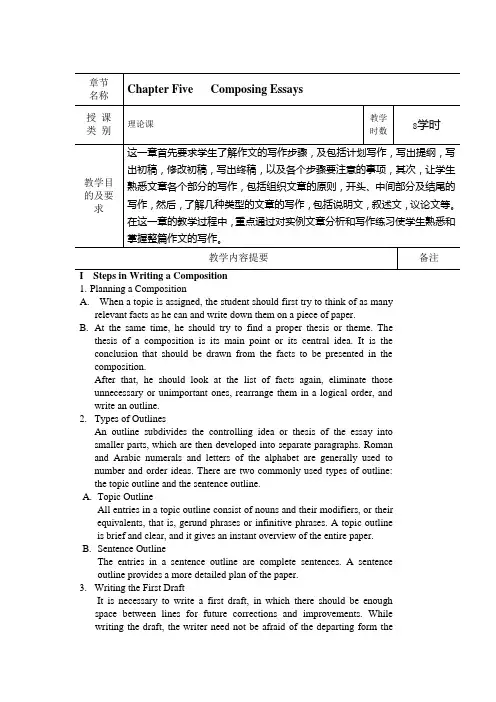
1.Planning a CompositionA. When a topic is assigned, the student should first try to think of as manyrelevant facts as he can and write down them on a piece of paper.B.At the same time, he should try to find a proper thesis or theme. Thethesis of a composition is its main point or its central idea. It is the conclusion that should be drawn from the facts to be presented in the composition.C.After that, he should look at the list of facts again, eliminate thoseunnecessary or unimportant ones, rearrange them in a logical order, and write an outline.2.Types of OutlinesAn outline subdivides the controlling idea or thesis of the essay into smaller parts, which are then developed into separate paragraphs. Roman and Arabic numerals and letters of the alphabet are generally used to number and order ideas. There are two commonly used types of outline: the topic outline and the sentence outline.A.Topic OutlineAll entries in a topic outline consist of nouns and their modifiers, or their equivalents, that is, gerund phrases or infinitive phrases. A topic outline is brief and clear, and it gives an instant overview of the entire paper.B.Sentence OutlineThe entries in a sentence outline are complete sentences. A sentenceoutline provides a more detailed plan of the paper.3.Writing the First DraftIt is necessary to write a first draft, in which there should be enough space between lines for future corrections and improvements. While writing the draft, the writer need not be afraid of the departing form theout line at one place or another. But he had better stop to revise his outline or work out a new one if he finds his original outline entirely impracticable.4.Revising the First DraftIf possible, a student should write the first draft one to two days before the time when he has to hand in the composition to the teacher. He will then have enough time for revising the draft, and be able to examine it more objectively.While revising a composition, the student should keep in mind that revision does not mean a simple correction of mistake in grammar, spelling, punctuation, and other mechanics.5.Making the Final CopyThe very last step in writing a composition, a step that should never be forgotten, is to check the final copy. In doing so the writer is likely to find that he has made careless mistakes in grammar and spelling, and he may also want to change a word here and there.II Organization1.Some PrinciplesA.Like a paragraph, a composition must have unity. A speaker may beallowed to digress from his main subject for a little while, but a writer is not given such freedom.B. A composition consists of several paragraphs, each of which has onecentral thought. They must be arranged in some kind of order, so that one paragraph leads naturally to another to form an organic whole.C.Proportion is as important to an essay as it is to a painting. Main facts orideas deserve full treatment; minor ones should be given less space. The essential part of an essay is the body or the middle part. To give this part about seven-or eight-tenths of the total space will be just right. The beginning and the end, though important, have to be short.2.The BeginningA.The beginning rouses the reader’s interest in and secures his attention tothe subject matter of the essay or provides necessary background information.B.The middle gives a clear and logical presentation of the facts and ideasthe writer intends to put forth.C.The end winds up the essay often with an emphatic and forcefulstatement to influence the reader’s final impression of the essay and shows the implication or consequences of the argument.Concluding paragraphs should be short, forceful, substantial, and thought-provoking, made up mainly of restatements or summaries of the points that have been discussed. No new ideas should be introduced in a concluding paragraph.Sometimes it is good to link the concluding paragraph to the introductory. If. For instance, a question is raised in the introductoryparagraph, an answer should be given in the concluding paragraph.III Types of Writing1.DescriptionA description essay is generally developed through sensory details, or theimpressions of one’s senses—sight, hearing, taste, smell, and touch. Not all details are useful. The writer should choose those that help to bring out the dominant characteristic or outstanding quality of the person or thing described, and leave out those irrelevant ones.A. Description of a personWhile describing a person, the writer should try to reveal the person’s character, thoughts, and feelings, which may be shown in what theperson does and says, or in how he behaves to others. And it is important to grasp the characteristic features that distinguish him from all other people.B. Description of a placePlaces may be described for their own sake, as in essays on visits to famous scenic places, but also for the purpose of revealing the personality and character of a person, or creating a feeling or mood. As in describinga person, in describing a place one should mainly write about the thingsthat make it different from other places.C. Description of an objectTo describe an object we have to depend on our senses, because we need to mention its size, shape, color, texture, taste, and smell. It is also necessary to tell how it is used if it is useful, and what part it plays in a person’s life if it is in some way related to him. But emphasis should be placed on only one aspect of the object, probably its most important characteristic.D. Description of a sceneA scene usually consists of three basic factors: the setting, the people,and the actions. It is also possible to describe the scene of some natural phenomenon.The writer should try to create a dominant impression when describing a scene. Before he begins to write, he must make up his mind as to what effect he wants the description to achieve. This will help him to decide which details to delete and which to include.2.NarrationTo narrate is to give an account of an event or a series of events. In itsbroadest sense, narrative writing includes stories, real or imaginary,biographies, histories, news items, and narrative poems.Narration often goes hand in hand with description. When planning anarrative, the writer should consider these five aspects: context, selectionof details, organization, point of view, and purpose.3.ExpositionExposition means expounding or explaining. Exposition mainly dealswith processes and relationships. We are writing a descriptive essaywhen we describe the appearance of an object; but we are writing an expository essay when we explain how it is made, how it is used, and how it may change. Things can be explained by illustration, process, classification and division, comparison and contrast, and analysis of their causes and effects or definition.The most important quality of exposition is clarity. To achieve this the writer should:A.Limit his subject or the scope of discussion, or it is impossible to explainmany things clearly in a short essay:B.Prepare enough material to help his explanation; the ordinary reader oftenfinds abstract discussions hard to follow if they are not illustrated by concrete examples;C.Present his facts and views in proper order.D.Pay attention to the accuracy and clarity of words and sentences; avoidornamental as well as ambiguous expressions.4.ArgumentationThe purpose of exposition is to inform; the purpose of argumentation, on the other hand, is to convince. While an expository paper makes know something and explains it to make the reader understand, an argumentative essay tries to make the reader agree with its point of view and support it. Argumentation is actually exposition with the additional purpose of convincing or persuading.If you wish to write a good argumentative essay, you should do your best to meet the following requirements:A.A debatable pointB.Sufficient evidenceC.Good logicD.Clear logicE.Good use of the other three types of writingF.An honest and friendly attitude。
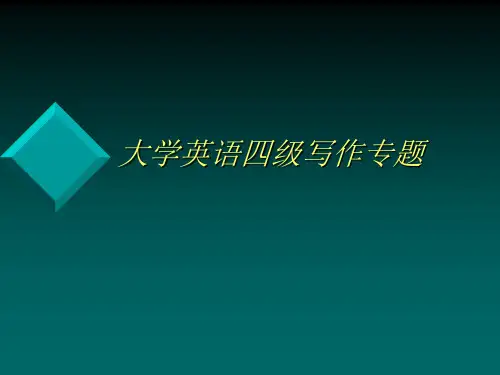



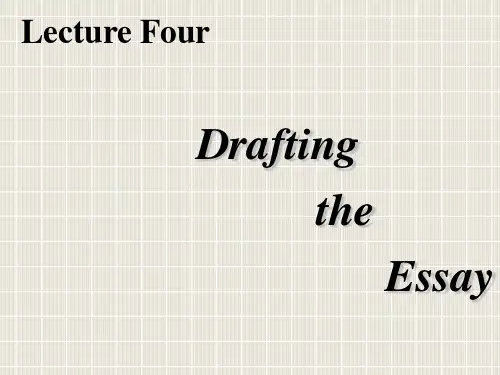

Chapter 6 Composing Essays6.2 Types of WritingThere are four types of writing: description, narration, exposition and argumentation.1. DescriptionGenerally, description is concerned with people, places and things. It is the art of translating the mental image (意象)of some object , person, place, or scene into words. It is a way of painting images in a certain logical pattern. The writer intends to tell how something looks like, sounds like, smells like, tastes like, or how one feels.2. Basic Elements of DescriptionAll descriptions involve two elements: the object –that which is seen or heard, and the observer— he who also sees or hears it.描写性文章有两大要素——描写对象和观察主体。
3. Basic Types of DescriptionDescriptions can be divided into two basic types: the objective and the subjective. Objective description attempts to report accurately the appearance of the object as a thing in itself, independent of the observer’s perception of it or feeling about it.(描写文可以分为两种:客观描写和主观描写。
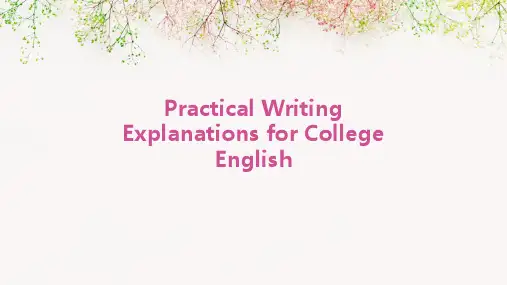
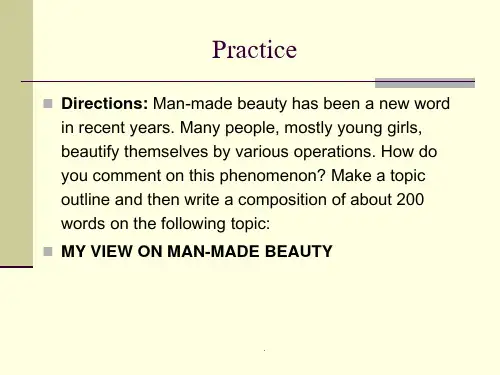
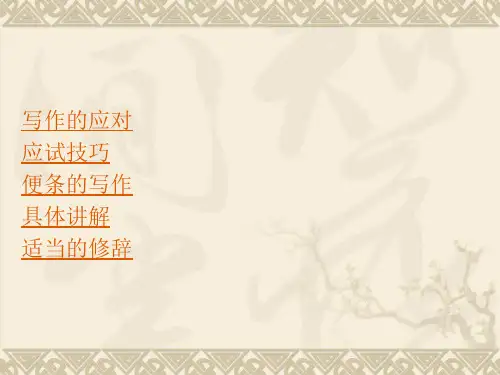
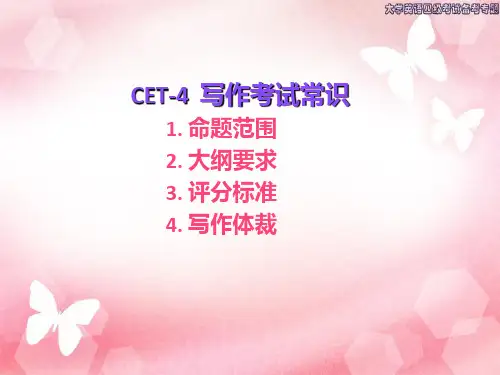
四级英语作文范文大全Title: Comprehensive Collection of Sample CET-4 English Essay。
In the realm of English language proficiency exams, the College English Test (CET) Level 4 is a pivotal milestone for many learners in China. Mastering English writingskills is essential for excelling in this examination.Here's a comprehensive collection of sample essays covering various topics to aid in your preparation:1. The Importance of Learning English:English, as a global language, holds paramount importance in today's interconnected world. Proficiency in English opens doors to various opportunities, including academic, career, and cultural enrichment. By mastering English, individuals can communicate effectively with people from diverse backgrounds and access a vastrepository of knowledge available in the language.2. The Impact of Technology on Society:Technology has revolutionized the way we live, work, and interact with one another. From smartphones to social media platforms, technological advancements have reshaped society in profound ways. While technology brings convenience and efficiency, it also raises concerns about privacy, social isolation, and job displacement. Therefore, it's crucial to strike a balance between harnessing the benefits of technology and mitigating its adverse effects.3. The Significance of Environmental Conservation:Environmental conservation is a pressing issue that demands global attention and concerted efforts. Human activities, such as deforestation, pollution, and climate change, pose significant threats to biodiversity and the sustainability of our planet. It's imperative for individuals, communities, and governments to adopt eco-friendly practices, promote renewable energy sources, and advocate for policies that safeguard the environment forfuture generations.4. The Role of Education in Shaping the Future:Education serves as the cornerstone of societal progress and individual development. It empowersindividuals with knowledge, critical thinking skills, and opportunities for personal growth. A well-rounded education system not only equips students with academic proficiency but also fosters creativity, empathy, and lifelong learning. Investing in education is investing in the future, as educated citizens contribute to a prosperous andsustainable society.5. Challenges and Opportunities in Globalization:Globalization has facilitated the free flow of goods, information, and people across borders, leading to unprecedented economic growth and cultural exchange. However, it also exacerbates issues such as income inequality, cultural homogenization, and geopolitical tensions. To harness the benefits of globalization whileaddressing its challenges, countries must prioritize inclusive economic policies, cross-cultural understanding, and international cooperation.6. The Power of Youth in Driving Social Change:Youth activism plays a pivotal role in drivingsocial change and shaping the future of our world. From advocating for climate action to promoting social justice, young people are at the forefront of grassroots movements worldwide. Their passion, creativity, and idealism inspire positive transformations and hold institutions accountable for addressing pressing issues. Empowering youth voices and fostering civic engagement are essential for building a more equitable and sustainable future.These sample essays provide a glimpse into the diverse topics that may be encountered in the CET-4 English examination. By honing your writing skills andfamiliarizing yourself with these themes, you can enhance your chances of success and effectively communicate your ideas in English. Remember to practice writing regularlyand strive for clarity, coherence, and conciseness in your essays. Good luck!。
Chapter 6 Composing EssaysFocus 1 Criteria of a Good CompositionWhat are the criteria of a good composition? We all know that it should have something interesting and/or important, and if possible, something new, to say and that this “something” is expressed clearly, accurately, and appropriately.We can see that before we write, we must decide on the purpose and audience of our writing and try to adapt the style and language to suit our purpose and audience.Focus 2 Steps in Writing a Composition1,Planning a CompositionWhen a topic is assigned, we should work out a plan and make sure that we have enough material.(1) Putting down all the relevant factsActually, what the writer should have done at the very beginning was to think of as many relevant facts as she could, make such a list as the one above, and then try to find a proper theme.(2) Thinking of a proper theme and deciding on our purposeHaving listed all the facts, we should think of a theme, that is, a controlling idea, and decide on our purpose.(3) Re-examining our list of details and outliningNow with our purpose in mind, we should look at the list again and cut out irrelevant, unnecessary, or unimportant details. Then we should rearrange the facts in a logical order and write and outline. While doing so, it may be necessary for us to add important details which will help us achieve our purpose.Sometimes, after the outline is written, we may find the topic we have first decided on does not express our central idea.(1) Types of outlineAn outline like the above is called a sentence outline, for it is made up of sentences. We see that the controlling idea or thesis is subdivided into smaller parts. Roman and Arabic numerals or letters of the alphabet are generally used to number and order ideas:Sample outline:Thesis: The war on drugs will do far more to control and eliminate illegal drug use in the USA than will the legalization of drugs.I. Epidemic proportions of drug problem in last decade have prompted efforts at all levels of society to address problemA. Three pronged effort of President's war on drugs - overview1. enforcement2. education3. treatmentB. Legalization also proposed by many as solution - overview of sketchy implementation planII. Arguments in favor of legalizationA. Takes away criminal element1. citation of Amsterdam experiment - Goldblatt2. analogy to legalized prostitution in Europe, NevadaB. Government can control drug quality and quantity1. FDA supervision2. more personnel and support requiredC. More revenue to support prevention and education1. estimates of revenue by Scheffer study2. analogy to revenue from state liquor operations - Maine, OklahomaIII. Arguments against legalizationA. Violates moral/ethical principles of country1. Taber's assessment of constitutional intention2. Heritage Foundation studyB. Makes drugs permanent fixture of society1. analogy to prostitution - Rosenburg study2. normalization lowers standards - Whitten's studyC. Encourages greater drug use by wider spectrum of users1. Post Vietnam study of mid size American cities2. Impact on middle class and youth - Fallow's viewsD. Subsidizes addiction with public money1. Amsterdam argument - Goldblatt's rebuttalE. Does not address causes of addiction - inner city survey from 1996IV. Three pronged war on drugs addresses supply, prevention, treatmentA. Coordinated law enforcement efforts at local, state, federal levels1. Legislative intent - McMurphy Bill2. sample cases from PA, MA, DC, CAB. Education - treatment programs at state - local levels1. success of NA based programs2. statistics on welfare cost saving3. 1997 Florida based studyC. Attention to factors encouraging drug dealing - addiction1. poverty and lack of education - Wilson data2. low self-esteem, lack of hope - AMA's new policy initiative3. lack of community involvement with youth - Center for Urban Studies position paperV. War on drugs clearly better than legalizationA. War on drugs is long range solutionB. War on drugs addresses underlying causesC. War on drugs consistent with country's valuesD. War on drugs will eventually end widespread drug useThere is another kind of outline called the topic outline. A topic outline consists of nouns and their modifiers, or their equivalents, that is, gerund phrases or infinitive phrases.Before writing a paper, we may prepare either a topic outline or a sentence outline. A sentence outline, on the other hand, provides a more detailed plan of the paper. It may take us less time to write a topic outline, but we may spend more time developing it into a paper; while spending more time working out a sentence outline, we sometimes find the paper almost half done after the detailed plan is written. For a short paper, a topic outline is often good enough, but for a long paper, it is perhaps better if we prepare a sentence outline.(2) Rules for writing outlines1. If there is a major point marked ”I”, there must be at least another marked “II”; if there is an “A”, there must be a “B”, and so on.2. A topic outline is written in noun phrases, and a sentence outline, in sentences. Sentences and phrases are not used together in the same outline.3. Parallel structures are used for the headings of the same rank. Subheads of like rank are of equal importance and are related to the heading and arranged in logical order.4. Thesis is a complete declarative sentence, usually in the affirmative. It is not a question, a phrase, or a dependent clause, but one sentence which expresses our controlling idea.To sum up, we should avoid single subdivisions; avoid mixing sentences and phrases in an outline; make sure that subheads of the same rank are of equal importance, are related to the headings I, II, and III, and are arranged in logical order; and always write the thesis in one complete sentence.2. Writing the First DraftNow that the outline is ready, we can begin to write the composition. While writing our draft, we may have some new ideas and depart from our outline at one place or another. This often happens, and we need not worry too much. All we have to do is to revise our outline or work out a new one if we find our original outline entirely impractical.When writing our first draft, it is advisable to leave both a margin and enough space between lines for future improvement.3. Revising the First DraftThis is an important step but it is often neglected. Furthermore, many people have the wrong idea that revision is simply a correction of mistakes in grammar, spelling, punctuation, and other mechanics. It certainly is not.If possible, we should write our first draft at least a day or two before the deadline, for then we may be able to examine it more objectively. When revising our draft, we should start from the content, which is the soul of a paper. The following checklist may be helpful:(1) Content: Look at the paper/composition as a whole.A. What is the topic of the paper/composition? Does the draft fulfill the assignment?B. Is the thesis clear? Is it supported by enough facts?C. Is there irrelevant material that should be removed?D. Is the logic sound? Are there gaps in the logic?(2) Organization: Look at the arrangement of the material.A. Does the introductory paragraph lead to the main point of the paper?B. Does each paragrap h have a separate central idea? Does it relate to the paper’s main idea or to the previous paragraph? Are there proper translations between sections? Are the paragraphs arranged in climactic order?C. Does the concluding paragraph give the reader a clear impression of what the paper intends to say?(3) Sentences:A. Is each sentence clearly related to the sentence before it and to the sentence after it?B. Are there unnecessary sentences that may be removed?C. Are there structural mistakes?D. Are there wordy and redundant sentences?E. Is there variety in sentence type?(4) Diction:A. Are there words that are not appropriate for the topic or the style of the whole paper?B. Are there words or phrases which are directly translated from Chinese but which may mean something different in English?C. Are there collections which may be correct because they are taken from Chinese?(5) Mistakes in grammar, spelling, punctuation, and other mechanics.From the list we can see that content and organization are most important to a paper. We should always make sure that we have something significant to say and that we express our ideas in good order. It is difficult and time-consuming to improve a draft which fails in these two respects, not to say that often we have to write another draft. Therefore, we should learn to plan our paper first. In this way, we may discover and correct whatever is unsatisfactory before we write our first draft.4. Making the Final CopyAfter we have carefully revised the draft, we are ready to make a clean final copy, following the rules of manuscript form. The last step in writing a paper is to check the final copy to correct careless mistakes in grammar and spelling before we hand it in.Focus 3 Three Main Parts of a CompositionMost compositions are made up of a beginning, a middle, and an end. We usually write one topic paragraph each for the beginning and the end, but for the middle, often more paragraphs are needed.1. The BeginningThe beginning rouses the readers’ interest and draws their attention to the subject matter of the paper and/or provides necessary background information. Though it is usually short, it is often the most important part for us to write, because we have to decide from what point to start, and in which direction to go.There are a number of possible ways to begin a paper, and for different types of writing, some approaches are often better than others:⏹The function --- to introduce⏹The purpose --- to propose one’s own argument“central idea” “topic sentence” “Thesis statement”A. 谚语法:用谚语提出自己的观点。